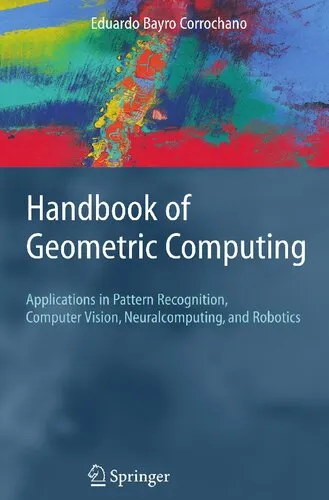Handbook of Geometric Computing. Applications in Pattern Recognition, Computer Vision, Neuralcomputing, and Robotics
4.0
Reviews from our users

You Can Ask your questions from this book's AI after Login
Each download or ask from book AI costs 2 points. To earn more free points, please visit the Points Guide Page and complete some valuable actions.Introduction to the Handbook of Geometric Computing
The "Handbook of Geometric Computing: Applications in Pattern Recognition, Computer Vision, Neuralcomputing, and Robotics," authored by Eduardo Bayro-Corrochano, provides a groundbreaking exploration of the intersection between advanced geometric computing techniques and their real-world applications. This book represents a pivotal contribution for both scholars and practitioners alike, delving into computational methods that leverage geometrical frameworks to solve complex problems in a wide variety of multidisciplinary fields.
Throughout its chapters, the book meticulously integrates concepts from geometric algebra, computer vision, robotics, and artificial intelligence, providing readers with a unified understanding of these diverse disciplines. Whether you're an academic researcher, a software engineer in search of optimization strategies, or a professional curious about the next frontier of computing, this book offers a wealth of practical and theoretical insights.
Written in a clear yet comprehensive manner, the handbook enhances the reader's knowledge by connecting mathematical principles with cutting-edge practical applications. Its topics are aimed at enabling software technologies and innovations in fields like pattern recognition, neural networks, and robotics to be more robust, efficient, and geometrically coherent.
Detailed Summary of the Book
The book starts with an in-depth introduction to the foundational concepts of geometric algebra and geometric computing, highlighting their significance in modern computational efforts. Starting with a review of mathematical frameworks, it progresses toward more robust discussions aimed at practical problem-solving. The author explains how geometric structures can simplify complex computational tasks while also improving accuracy.
Key applications are explored in great detail, particularly in the realms of computer vision and pattern recognition. Readers will gain insights into how geometric computing models can enhance image recognition, improve object detection algorithms, and create strategies for robust feature extraction. It makes a strong case for replacing traditionally rigid linear spaces with more flexible geometric representations.
The inclusion of neural computing and robotics gives the book an even broader domain of relevance. It meticulously discusses how geometric tools can improve neural network architectures and lead to better hierarchical decisions in robotics, including manipulation and path planning. Readers will appreciate how these chapters blend theory, algorithms, and applications naturally, backed by illustrative examples.
Key Takeaways
- A deep understanding of geometric algebra and how it can unify diverse computational frameworks.
- Practical solutions and algorithms for pattern recognition and computer vision leveraging geometrical models.
- Insights into how geometric computing empowers neural networks by improving their structure and functionality.
- Advanced techniques applicable in robotics for navigation, manipulation, and sensor data interpretation.
- A foundation for building more efficient, coherent, and flexible software frameworks using geometrical computing methods.
Famous Quotes from the Book
"Geometric computing is not merely a computational tool; it is a revolution in abstraction and implementation that touches nearly every computational domain."
"By integrating geometry into algorithms, we embrace a more natural and expressive method of solving problems—from artificial intelligence to robotics."
"The beauty of geometric algebra is its ability to simplify the complex while enhancing computational integrity."
Why This Book Matters
The "Handbook of Geometric Computing" matters because it addresses a crucial gap in the computational sciences by offering a unified geometric framework. In a world increasingly dominated by complex datasets, artificial intelligence models, and autonomous systems, understanding and applying geometric computing principles is more critical than ever. This book pushes the boundaries of what is possible by making mathematics not only accessible but also actionable.
It lays out tools and techniques that promise to make computational models faster, more intuitive, and more aligned with physical and visual realities. The applications, from robotics to neural computing, encapsulate the future of problem-solving through more efficient and geometrically consistent approaches. By mapping theory to real-world contexts, Eduardo Bayro-Corrochano ensures the book remains relevant for years to come.
In essence, this handbook is indispensable for anyone looking to drive innovation in scientific research, industrial solutions, or computational models. Its synthesis of groundbreaking theory and hands-on application makes it a cornerstone resource for geometric computing.
Free Direct Download
You Can Download this book after Login
Accessing books through legal platforms and public libraries not only supports the rights of authors and publishers but also contributes to the sustainability of reading culture. Before downloading, please take a moment to consider these options.
Find this book on other platforms:
WorldCat helps you find books in libraries worldwide.
See ratings, reviews, and discussions on Goodreads.
Find and buy rare or used books on AbeBooks.
1212
بازدید4.0
امتیاز50
نظر98%
رضایتReviews:
4.0
Based on 0 users review
"کیفیت چاپ عالی بود، خیلی راضیام"
Questions & Answers
Ask questions about this book or help others by answering
No questions yet. Be the first to ask!


